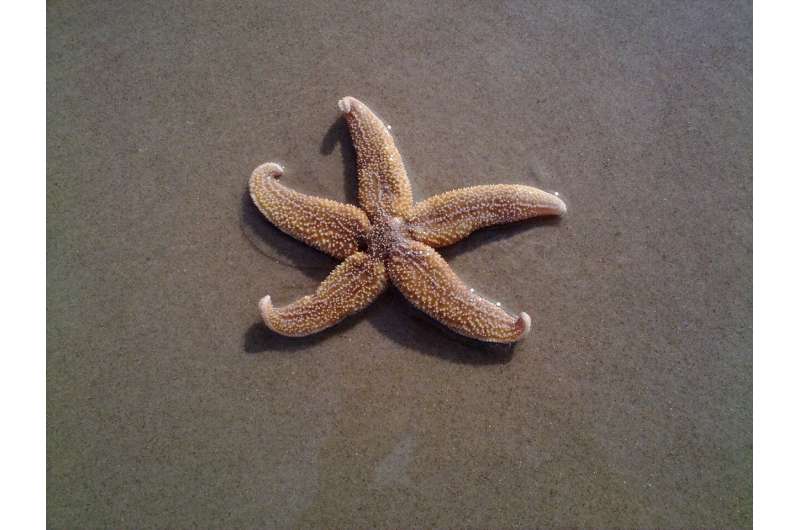Chemical signals discovered in starfish that stop feeding behavior

Starfish feed in a bizarre way—turning their stomachs out of their mouth when they come across a tasty meal like a mussel or oyster—and then digesting their chosen prey outside of their body.
Previous studies have shown that molecules similar to the human "love hormone" oxytocin cause starfish to extend their stomach out of their mouths and initiate feeding. However, it was not known which chemicals have the power to do the opposite and terminate feeding behavior in these animals.
Using the common starfish Asterias rubens for experiments, the research team investigated the effects of SK/CCK-type neuropeptides—a type of hormone known to inhibit feeding in humans and insects. They found that when they injected the hormones into the starfish, the animals retracted their stomachs. Even when the scientists presented the starfish with their favorite meal, a mussel, they found that the starfish were less inclined to feed after being injected with the SK/CCK-type neuropeptides.
Starfish belong to a group of animals known as echinoderms. Echinoderms occupy a unique evolutionary position, acting as a "missing link" between well-studied vertebrates and insects such as the fruit fly, Drosophila. This feature makes starfish and other echinoderms like sea urchins, useful animal models to help fill in gaps in our understanding of how different proteins evolved.
Dr. Ana Tinoco, Postdoctoral Research Assistant at Queen Mary and one of the lead authors of the study, said: "The unusual way that starfish feed where they evert their stomachs out of their mouths, makes them a good model to study chemicals that regulate feeding processes. Whilst we already knew that this type of hormone was important for feeding, what's fascinating is that the important role of these chemicals in feeding in other animals has been preserved in starfish despite their dramatically different feeding behavior, lack of a brain and unique body plan."
Professor Maurice Elphick, Professor of Physiology and Neuroscience at Queen Mary, said: "Our findings provide new evidence that SK/CCK-type neuropeptides have an evolutionarily conserved role as inhibitory regulators of feeding. The discovery of SK/CCK-type neuropeptides in starfish could also be useful for development of novel drugs to treat eating disorders. To accomplish this, more research needs to be done to determine the 3D structure of the receptor proteins that mediate effects of SK/CCK-type neuropeptides in humans and other animals.
"With recent breakthroughs in the use of AI to determine protein structures the potential of using basic science research like this to develop new treatment options becomes much more achievable."
More information: Ana B Tinoco et al, Ancient role of sulfakinin/cholecystokinin-type signalling in inhibitory regulation of feeding processes revealed in an echinoderm, eLife (2021). DOI: 10.7554/eLife.65667
Journal information: eLife
Provided by Queen Mary, University of London
















